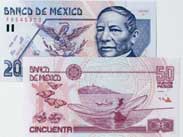Mexican Economy
Economy of Mexico
 The Mexican economy is the 14th largest economy in the world, (as studied in 2006). The Mexican economy consists of a mixture of modern, outmoded industry and agriculture. Both the sectors are increasingly dominated by the private sector. It is an export oriented economy, which today is recognized as an upper middle-income economy. Sensitivity towards poverty on the part of officials has had a positive effect, resulting in rising income levels. Nevertheless poverty rates remain high and so does income inequality.
The Mexican economy is the 14th largest economy in the world, (as studied in 2006). The Mexican economy consists of a mixture of modern, outmoded industry and agriculture. Both the sectors are increasingly dominated by the private sector. It is an export oriented economy, which today is recognized as an upper middle-income economy. Sensitivity towards poverty on the part of officials has had a positive effect, resulting in rising income levels. Nevertheless poverty rates remain high and so does income inequality.
The population of Mexico was 104.2million in 2006 as estimated by the World Bank. According to the World Bank records over 45 percent of the countries population was living in moderate poverty and 18 percent was living under extreme poverty in 2005. The country has achieved a moderate average growth rate of 2 percent per year in per capita income from 1996-2005. Though in 2004, the growth rate has been an impressive 4.2 percent, and 5.1 percent in the first semester of 2006. The agriculture sector contributed 3.9% to the GDP and the industries added value worth 26.7% to the GDP. Also it is the only Latin American member of the organization for Economic Co-operation and Development.
The agriculture sector got a push after the Mexican revolution, when the agrarian reforms were introduced. Until the 1990's the government promoted the production of basic crops like corn and beans. With trade liberlisation however the National Company for Popular Subsistence (CONASUPO) was gradually dismantled. Agriculture, as a percentage of GDP, has been steadily declining, a trend that resembles that of developed nations, in that it plays a smaller role in the economy. In 2006, agriculture accounted for only 3.9% of GDP, down from 7% in 1980. What is interesting to note here is that corn is though a staple food item in Mexico , yet it does not have the advantage of being a part of agriculture but a part of horticulture, tropical fruits and vegetables.
Mexico exports commodities like oil and oil products, silver, fruits, vegetables, coffee, and cotton. The main destinations for these goods are the US , Canada , Germany , and Spain . In 2005 Mexico , was the world's fifteenth largest merchandise exporter and twelfth largest merchandise importer with a 12 percent increase in overall trade. Mexico alone exports commodities worth US $213.7 hence being known as the biggest exporter and importer in Latin America . Mexico joined GATT in 1986 and is an active and constructive participant of the World Trade Organisation.
Mexico has signed free trade agreements with 12 countries such as the US , Bolivia , Chile , Israel , Costa Rica , and Canada . One of the more important free trade agreements that Mexico has signed is the North American Free Trade Agreement (NAFTA) with the US . The NAFTA was supplemented by the North American agreement for environmental cooperation (NAAEC) and the North American Agreement on labour Cooperation. Considering the amount of trade between the US and Mexico , there are relatively few disputes. Mexico 's economic growth has hence come to depend the US economic cycle. This is, reflected not only on gross fixed investments and exports but also in the employment, wages and private consumption. Tourism from the United States and border transaction produce billions of dollars for Mexico . An open environment foreign trade and investment and an ever growing domestic market always makes for an attractive destination for foreign direct investments.
Though regional disparities and income inequality continue to hamper the countries growth, the human development index of the nation remains above a superior 0.70. The northern and the central states have higher levels of HDI as compared to the southern.
The economic crisis in 1994 popularly known as the Mexican peso crisis was prompted by the sudden devaluation of the Mexican peso. The crisis was handled relatively quickly. Though when the NAFTA was signed the economic future of the country looked bright, this recovery was due to the immediate response of the US government and the IMF in providing loans. The year also saw a radical rebellion in the state of Chipas.
The country faced another challenge in the 1980's. It was the financial crisis of 1982. The Mexican government at this time had already exposed itself to the ills of the US economy. It borrowed extensively to finance investments in the infrastructure and industry. It also gambled earnings from tourism and exports. The very size of the debt was approximately $70 billion in January and $80 billion by October. Mexico lost the gamble. The United States raised the cost of dollars to slow down the inflation but in the process that step inflated the economy of Mexico . The Mexican economy was already fragile due to president Portillo's policies now the situation only worsened as the Mexican economists projected an inflation rate of 60%.
Mexico is also a leading implementer of Global Environment Facility grant and other products that help to counter environmental degradation.